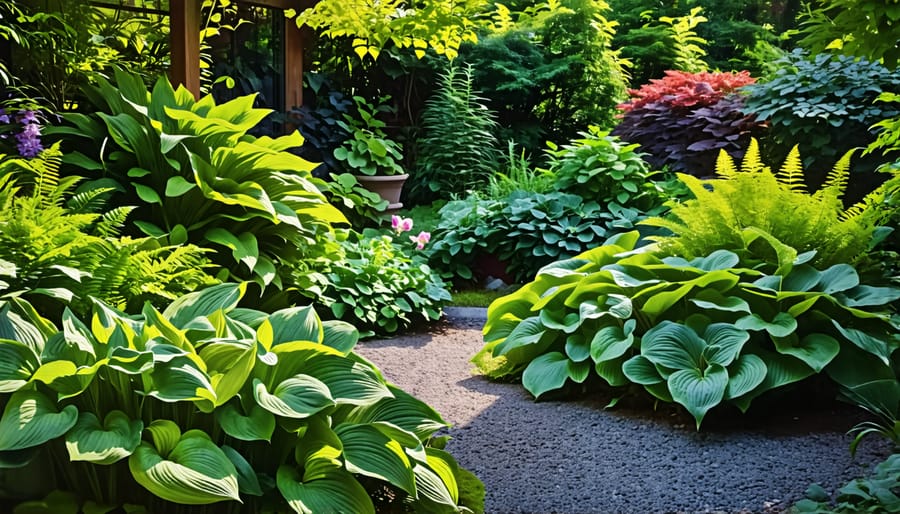Introduction
Creating a shade garden is an excellent way to transform those underutilized, low-light areas of your yard into a beautiful, tranquil retreat. Unlike sun-drenched gardens, shade gardens require careful plant selection and thoughtful design to thrive. Whether you’re working under tall trees, beside your house, or in a naturally shaded corner, building a shade garden allows you to enjoy vibrant greenery and colorful blooms without direct sunlight.
In this article, you’ll discover everything you need to build a shade garden that flourishes. From choosing the right plants and preparing your soil to understanding light levels and watering needs, we’ll cover expert strategies and actionable tips. By the end, you’ll have a clear roadmap to creating a lush shade garden that enhances your outdoor living space.
Understanding Shade Garden Basics
What Defines a Shade Garden?
A shade garden is a planting area where sunlight is limited, typically receiving less than 4 hours of direct sun daily. There are different types of shade:
- Full shade: Less than 2 hours of direct sunlight, mostly indirect light.
- Partial shade: 2 to 4 hours of direct sun, often morning sun with afternoon shade.
- Dappled shade: Filtered sunlight through tree leaves.
Knowing your garden’s shade type is crucial because it influences plant choice and garden design.
Why Build a Shade Garden?
Shade gardens offer several benefits:
- Utilizes spaces unsuitable for sun-loving plants.
- Provides a cool, relaxing retreat during hot months.
- Supports biodiversity by attracting shade-tolerant wildlife.
- Reduces soil erosion under tree canopies.
Understanding these benefits helps gardeners appreciate shade areas as valuable garden assets.
Choosing the Right Plants for Shade
Top Shade-Tolerant Plants
Selecting plants adapted to low-light conditions is key. Some expert-recommended options include:
- Hostas: Known for their lush foliage and variety of sizes.
- Ferns: Such as Japanese painted fern and maidenhair fern, add texture.
- Astilbe: Produces vibrant plume-like flowers.
- Heuchera (Coral Bells): Offers colorful leaves year-round.
- Impatiens: Bright annuals that thrive in shade.
Consider Plant Requirements
Even shade plants have specific needs:
- Soil moisture: Many shade plants prefer moist, well-draining soil.
- Soil acidity: Some plants, like azaleas, thrive in acidic soils.
- Space and growth habits: Plan for mature sizes to avoid overcrowding.
Expert Tip
Group plants with similar light and water needs together. This simplifies care and ensures all plants thrive equally.
Preparing the Site and Soil
Assess Soil Conditions
Shade garden soils often suffer from compaction and nutrient depletion due to tree roots. Follow these steps:
- Test your soil for pH and nutrient levels using a home kit or extension service.
- Amend the soil with organic matter like compost or well-rotted leaf mold to improve structure and fertility.
- Loosen compacted areas carefully to avoid damaging tree roots.
Improve Drainage
Good drainage prevents root rot common in shaded areas. Consider raised beds or adding sand to heavy clay soils.
Mulching Benefits
Apply a 2-3 inch layer of organic mulch such as shredded bark or leaves. Mulch:
- Conserves moisture
- Suppresses weeds
- Adds nutrients as it decomposes
Designing Your Shade Garden
Layout and Planting Strategy
- Use layers: Combine ground covers, mid-height perennials, and taller shrubs to create depth.
- Incorporate pathways and seating areas to encourage use of the space.
- Add texture and color through diverse foliage and seasonal flowers.
Lighting and Accessories
Since natural light is limited, consider:
- Garden lights or solar lanterns to highlight features.
- Reflective surfaces like light-colored stones or mirrors to brighten the space.
Maintenance Tips
- Regularly check moisture levels; shaded gardens can dry out unpredictably.
- Prune trees judiciously to increase light if possible.
- Control pests like slugs and snails, which thrive in damp shade.
Common Challenges and Solutions
Dealing with Dry Shade
Some shaded areas are also dry, making plant selection tricky. Choose drought-tolerant shade plants like:
- Lamium
- Epimedium
- Liriope
Amend soil with moisture-retaining organic matter and mulch well.
Managing Tree Roots
Tree roots compete for water and nutrients. Strategies include:
- Using raised beds or containers.
- Applying root barriers.
- Selecting shallow-rooted plants.
Conclusion
Building a shade garden offers a rewarding way to enhance those less sunny parts of your outdoor space. By understanding your garden’s light conditions, selecting suitable plants, and preparing the soil properly, you set the stage for a thriving, low-maintenance oasis. Thoughtful design and maintenance ensure your shade garden remains vibrant and inviting year-round.
Take time to experiment and observe how your plants respond; each shade garden is unique. With patience and care, you can create a peaceful retreat filled with texture, color, and life — even in the shadiest corners of your yard.
